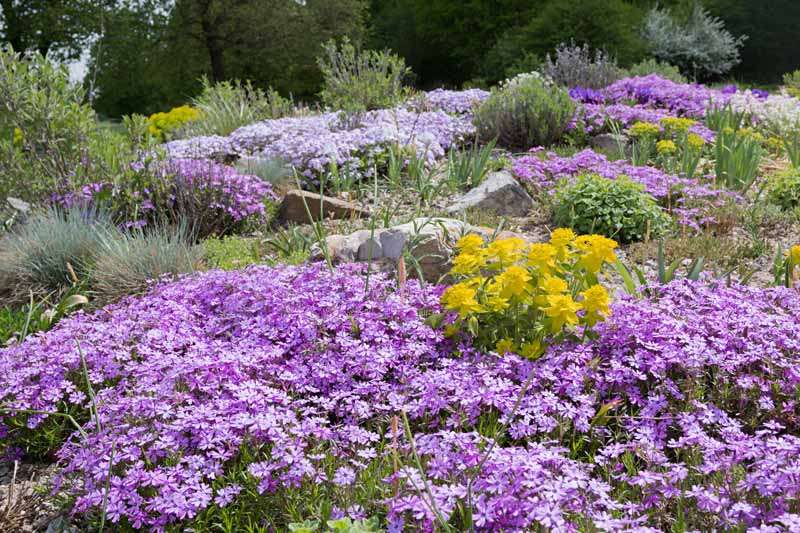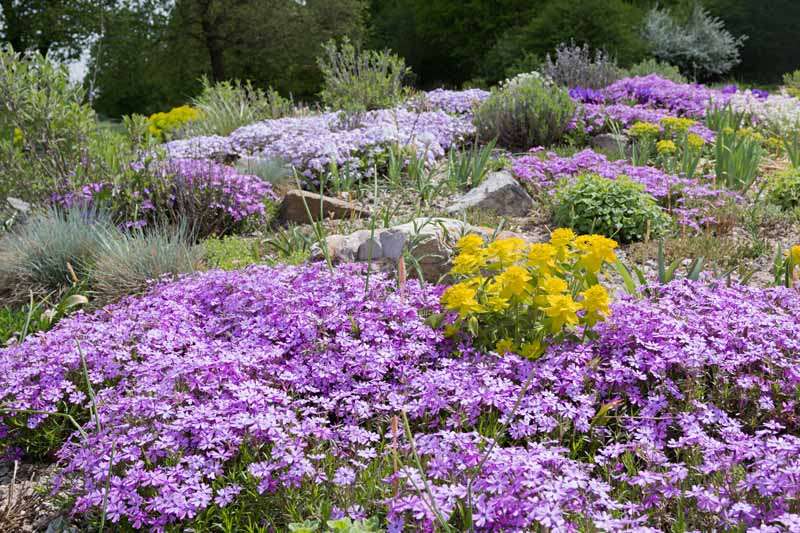If you’re looking to enhance the beauty and health of your garden, consider incorporating ground cover plants. Unlike traditional mulch, ground cover plants offer a visually appealing alternative that not only stabilizes the soil and controls erosion, but also suppresses weeds and retains water more effectively. Some ground cover plants even enrich the soil with nutrients. However, it’s important to choose the right plants for your area, as invasive ones can quickly overtake your garden. By selecting non-invasive varieties, you’ll create a natural habitat for beneficial insects and attract pollinators, all while adding a touch of beauty to your outdoor space.
1. Creeping Thyme
Description
Creeping Thyme, also known as Thymus praecox, is a versatile ground cover plant that adds beauty and fragrance to your garden. It features small, aromatic leaves and clusters of flowers that range in color from white to pink and purple. Creeping Thyme spreads quickly, forming a dense mat that can grow up to 3 inches tall.
Benefits
This low-growing herbaceous perennial offers several benefits for your garden. Firstly, Creeping Thyme is excellent for stabilizing soil and controlling erosion on slopes or embankments. Its extensive root system helps prevent soil erosion by holding the soil in place. Additionally, its dense mat acts as a natural weed suppressant, reducing the need for herbicides or manual weeding.
Moreover, Creeping Thyme is a nitrogen fixer, meaning it absorbs nitrogen from the air and converts it into a usable form for plants. This enriches the soil with nutrients, promoting the healthy growth of other plants in your garden. Furthermore, this ground cover plant is drought-tolerant and can help retain water more effectively than traditional mulch, reducing the need for frequent watering.
Maintenance
To keep your Creeping Thyme looking its best, regular maintenance is necessary. It benefits from light pruning after flowering to encourage new growth and maintain its compact shape. Additionally, you should remove any dead or damaged foliage to prevent disease or pests from infesting the plant.
Watering is essential during the establishment phase, but once it has developed a strong root system, Creeping Thyme is relatively drought-tolerant and requires minimal watering. However, in extreme heat or prolonged dry spells, it is advisable to water the plant to ensure its health and vitality.
Suitable Areas
Creeping Thyme is suitable for various areas in your garden, such as rock gardens, slopes, pathways, or as a border plant. It thrives in full sun to partial shade and prefers well-draining soil. This ground cover plant can tolerate a wide range of soil types, including sandy or rocky soil. Creeping Thyme is hardy in USDA zones 4-9, making it a versatile choice for many climates.
2. Corsican Mint
Description
Corsican Mint, scientifically known as Mentha requienii, is a delightful and aromatic ground cover plant that is perfect for filling in small spaces. It features tiny, round leaves that release a minty fragrance when brushed against. The leaves of Corsican Mint range in color from dark green to purple, and it produces small, lilac-colored flowers in summer.
Benefits
Corsican Mint offers several benefits that make it a great addition to your garden. Firstly, its low-growing and dense nature makes it ideal for filling gaps between pavers, stepping stones, or in rock gardens. It creates a beautiful carpet-like effect that adds a touch of vibrancy to your outdoor space.
Furthermore, Corsican Mint releases a refreshing mint aroma when stepped on or brushed against, making it a sensory delight. It is also an excellent choice for attracting pollinators such as bees and butterflies to your garden.
Maintenance
Maintaining Corsican Mint is relatively easy. This ground cover plant prefers moist soil, so regular watering is necessary, especially during dry periods. However, be cautious of overwatering, as the plant can be sensitive to excess moisture. It is best to allow the soil to dry slightly between waterings.
To prevent the plant from becoming invasive, regular trimming is advisable. Trimming will help maintain its compact form and prevent it from spreading excessively. Additionally, removing any dead or yellowed leaves will keep the plant healthy and aesthetically pleasing.
Suitable Areas
Corsican Mint thrives in shady or partially shaded areas of your garden, such as under trees or along pathways. It prefers well-draining soil that retains moisture but does not become waterlogged. Corsican Mint is hardy in USDA zones 6-9 and performs best in temperate climates.
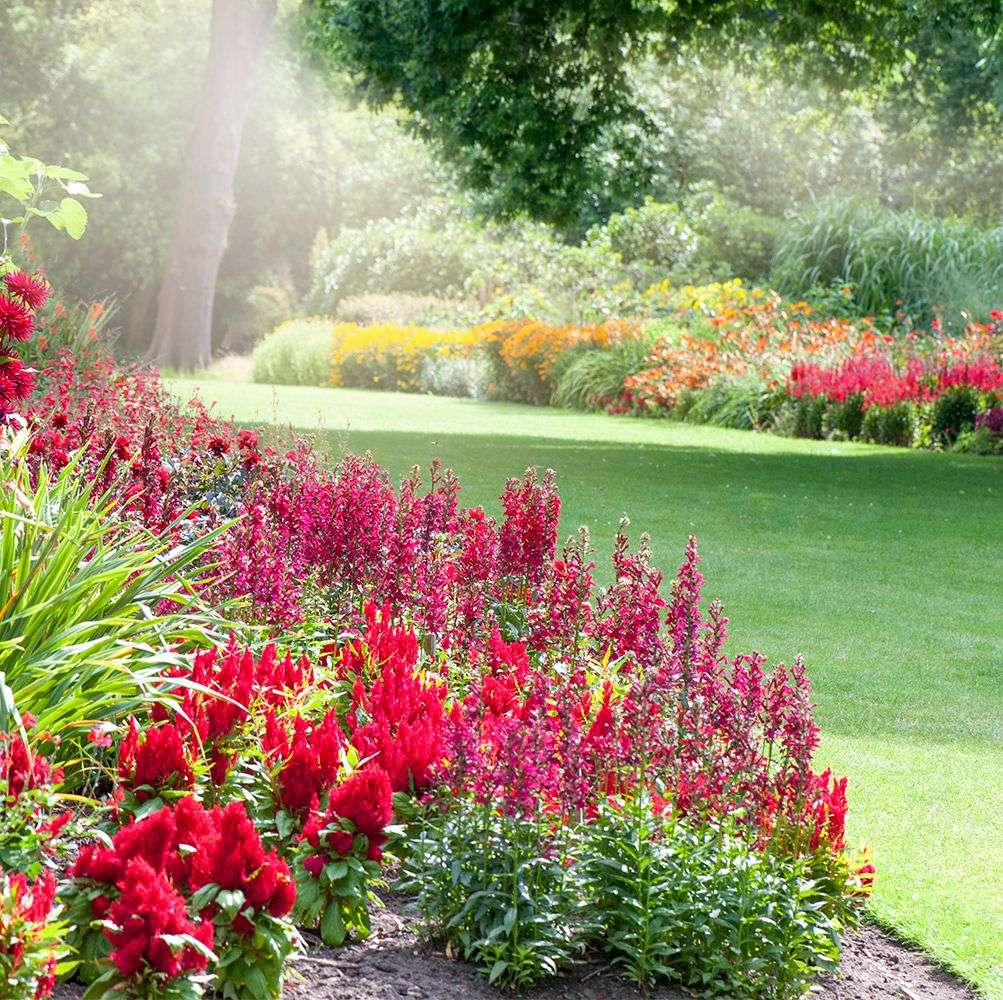
3. Creeping Jenny
Description
Creeping Jenny, scientifically known as Lysimachia nummularia, is a vigorous and trailing ground cover plant that adds a splash of vibrant color to your garden. It features rounded leaves that range from bright green to yellow, depending on the variety. Creeping Jenny produces small, yellow flowers in late spring or early summer.
Benefits
Creeping Jenny offers several benefits for your garden. Firstly, it is excellent for stabilizing soil and controlling erosion, making it an ideal choice for slopes or embankments. Its fast-spreading nature quickly forms a dense mat that helps prevent soil erosion and acts as natural ground cover.
Moreover, Creeping Jenny is known for its vibrant and eye-catching foliage. Its bright yellow or green leaves add a pop of color to your garden beds, containers, or hanging baskets. Additionally, this ground cover plant attracts beneficial insects such as bees and butterflies, promoting a healthy ecosystem in your garden.
Maintenance
Maintaining Creeping Jenny is relatively straightforward. This plant thrives in moist soil, so regular watering is necessary, especially during dry spells. However, be cautious not to overwater, as excess moisture can lead to root rot. It is essential to allow the soil to dry slightly between waterings to prevent waterlogged conditions.
Trimming is also necessary to keep Creeping Jenny under control. It has a tendency to spread aggressively, so regular pruning will help maintain its desired shape and prevent it from becoming invasive. Additionally, removing any dead or damaged foliage will contribute to the overall health and appearance of the plant.
Suitable Areas
Creeping Jenny is a versatile ground cover plant that works well in various areas of your garden. It thrives in full sun to partial shade and prefers moist, well-draining soil. This plant can tolerate wet conditions, making it an excellent choice for areas near ponds or water features. Creeping Jenny is hardy in USDA zones 3-9, making it suitable for different climates.
4. Dwarf Mondo Grass
Description
Dwarf Mondo Grass, scientifically known as Ophiopogon japonicus, is a compact and attractive ground cover plant that resembles short, dense tufts of grass. It features narrow, strap-like leaves that range in color from dark green to black. Dwarf Mondo Grass produces small, inconspicuous flowers, followed by blackberry-like fruit.
Benefits
Dwarf Mondo Grass offers several benefits for your garden. Firstly, its low-growing and clumping nature makes it perfect for creating borders or edging in your landscape. It forms a neat and uniform appearance that adds structure and definition to your outdoor space.
Additionally, Dwarf Mondo Grass is a resilient and hardy plant that can tolerate a wide range of growing conditions. It thrives in both sun or shade, making it a versatile choice for different areas of your garden. Its dense foliage also helps suppress weed growth, reducing the need for manual weeding or herbicides.
Maintenance
Maintaining Dwarf Mondo Grass is relatively low maintenance. This plant is drought-tolerant once established, but regular watering during the initial stages is necessary to encourage root growth. Afterward, watering can be reduced, although it is still essential to monitor soil moisture and provide supplemental water during prolonged dry periods.
To keep Dwarf Mondo Grass looking tidy, occasional trimming is recommended. Trimming will help remove any damaged or discolored foliage and promote new growth. However, avoid cutting the plant too short, as it relies on its foliage for photosynthesis and overall health.
Suitable Areas
Dwarf Mondo Grass is suitable for a variety of areas in your garden, including borders, slopes, or as an underplanting for taller shrubs or trees. It can thrive in both full sun and shade, although it may require more frequent watering in full sun conditions. Dwarf Mondo Grass is hardy in USDA zones 6-11, making it suitable for most regions.
5. Woolly Thyme
Description
Woolly Thyme, scientifically known as Thymus pseudolanuginosus, is a low-growing and trailing ground cover plant that adds a unique and textural element to your garden. It features tiny, woolly leaves that are gray-green or silver-gray in color. Woolly Thyme produces small, pink or purple flowers in early summer, attracting pollinators to your garden.
Benefits
Woolly Thyme offers several benefits that make it a valuable addition to your garden. Firstly, its dense and mat-like growth habit helps stabilize soil on slopes or embankments, preventing erosion and promoting soil health. It also acts as a natural suppressor of weed growth, reducing the need for herbicides or manual weeding.
Moreover, Woolly Thyme’s silver-gray foliage provides a striking contrast to other plants in your garden. It adds a unique and textural element that enhances the overall visual appeal of your outdoor space. Additionally, this ground cover plant is drought-tolerant and can withstand dry conditions without significant loss of vigor.
Maintenance
Maintaining Woolly Thyme is relatively simple. This plant thrives in well-draining soil and prefers to be on the drier side. It is drought-tolerant but will benefit from occasional watering during prolonged dry periods to maintain its health and vigor. However, be cautious not to overwater, as excess moisture can lead to root rot.
To keep Woolly Thyme looking its best, occasional pruning is recommended. Trimming will help maintain its shape and prevent it from spreading excessively. Additionally, removing any dead or yellowed foliage will promote new growth and overall plant health.
Suitable Areas
Woolly Thyme is suitable for a variety of areas in your garden, such as rock gardens, borders, or as a ground cover for larger areas. It thrives in full sun and well-draining soil and is tolerant of poor or sandy soils. Woolly Thyme is hardy in USDA zones 4-9, making it a versatile choice for many climates.
6. Mazus reptans
Description
Mazus reptans, commonly known as Creeping Mazus, is a low-growing and spreading ground cover plant that features small, rounded leaves and delicate, colorful flowers. The leaves of Mazus reptans are bright green and create a dense carpet-like effect, while its flowers range in color from white to purple.
Benefits
Mazus reptans offers several benefits for your garden. Firstly, its low-growing and spreading nature makes it ideal for filling in gaps between pavers, stepping stones, or as an underplanting for taller plants. It creates a lush and vibrant ground cover that adds visual interest to your outdoor space.
Additionally, Creeping Mazus is a great choice for attracting pollinators such as bees and butterflies. Its delicate flowers provide a valuable food source for these beneficial insects, promoting a healthy and diverse ecosystem in your garden. Furthermore, this ground cover plant can help stabilize soil and control erosion when planted on slopes or embankments.
Maintenance
Maintaining Mazus reptans is relatively straightforward. This plant prefers evenly moist soil, so regular watering is necessary, especially during dry periods. However, be cautious not to overwater, as excessive moisture can lead to root rot. It is essential to monitor soil moisture and ensure proper drainage to prevent waterlogged conditions.
To maintain its desired shape and prevent overgrowth, occasional trimming is recommended. Trimming will help control its spread and promote new growth. Additionally, removing any dead or spent flowers will encourage prolonged blooming and overall plant health.
Suitable Areas
Mazus reptans is suitable for various areas in your garden, such as rock gardens, borders, or as a ground cover around ponds or water features. It thrives in partial shade to full sun and prefers well-draining soil. Creeping Mazus is hardy in USDA zones 5-9, making it suitable for a wide range of climates.
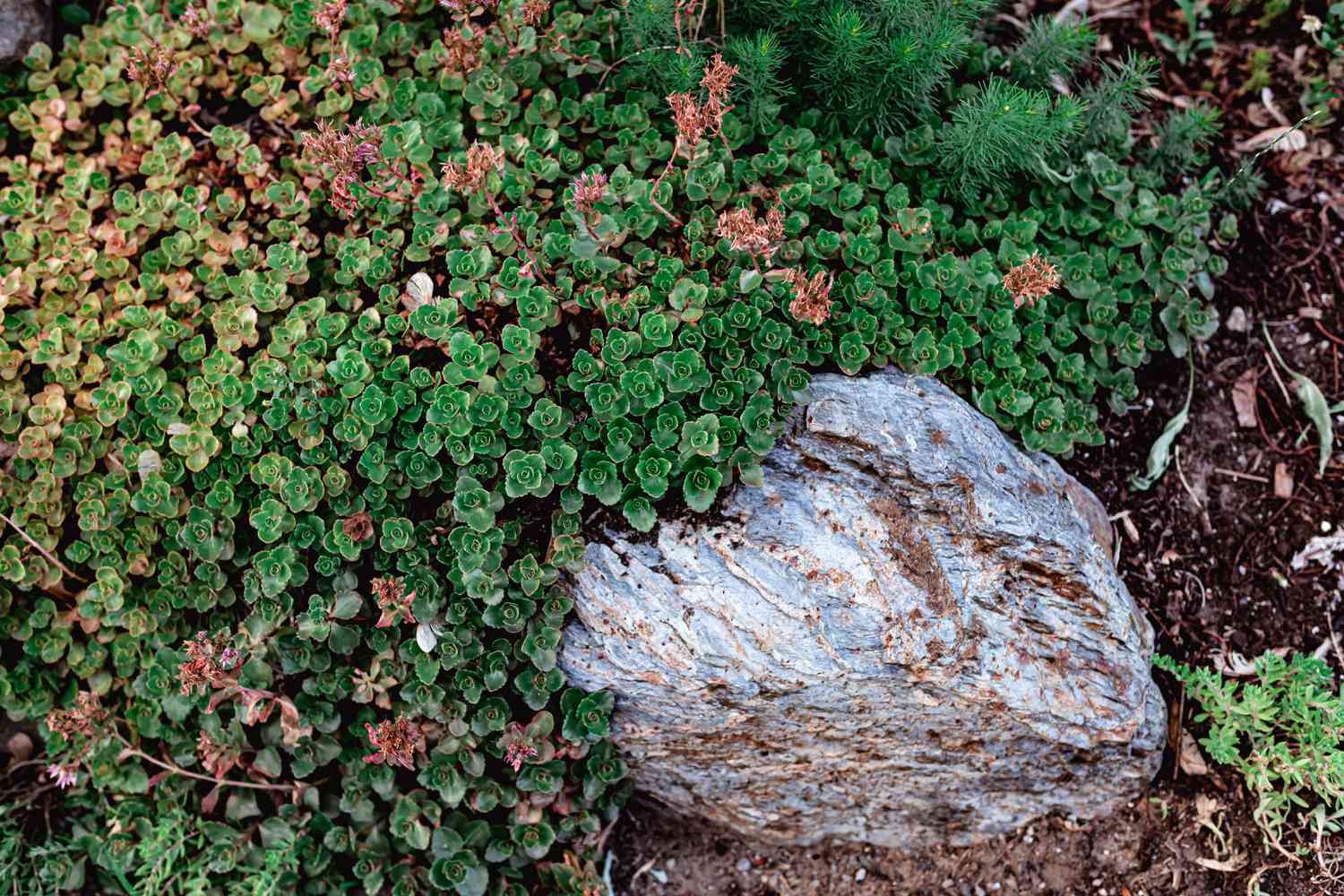
7. Blue Star Creeper
Description
Blue Star Creeper, scientifically known as Laurentia fluviatilis, is a fast-growing and mat-forming ground cover plant that features small, star-shaped blue flowers and lush green foliage. It spreads quickly, creating a dense carpet-like effect in your garden.
Benefits
Blue Star Creeper offers several benefits for your garden. Firstly, its rapid growth and mat-forming nature make it an excellent choice for filling in larger areas or as an underplanting for taller plants. It quickly forms a dense mat that helps suppress weed growth and prevents soil erosion.
Moreover, Blue Star Creeper is known for its delicate and beautiful blue flowers. It adds a touch of color and visual interest to your garden, attracting butterflies and other pollinators. Additionally, this ground cover plant is relatively low-maintenance and requires minimal pruning or care.
Maintenance
Maintaining Blue Star Creeper is relatively easy. This plant prefers moist soil, so regular watering is necessary, especially during dry periods. However, be cautious not to overwater, as excessive moisture can lead to root rot. It is essential to allow the soil to dry slightly between waterings to promote healthy growth.
To prevent overgrowth and maintain its shape, occasional trimming is recommended. Trimming will help control its spread and promote new growth. Additionally, removing any spent or faded flowers will encourage prolonged blooming and overall plant health.
Suitable Areas
Blue Star Creeper is suitable for various areas in your garden, such as pathways, rock gardens, or as a ground cover between stepping stones. It prefers full sun to partial shade and well-draining soil. Blue Star Creeper is hardy in USDA zones 6-10, making it suitable for most regions.
8. Irish Moss
Description
Irish Moss, scientifically known as Sagina subulata, is a low-growing and moss-like ground cover plant that features dense cushions of tiny, emerald-green leaves. It creates a lush and carpet-like effect in your garden and produces delicate white flowers in spring or early summer.
Benefits
Irish Moss offers several benefits for your garden. Firstly, its dense cushions of tiny leaves create a unique and luxurious texture that adds visual interest to your outdoor space. It provides a lush and carpet-like appearance, perfect for filling in gaps or as an underplanting for taller plants.
Additionally, Irish Moss is a great choice for stabilizing soil and controlling erosion. Its mat-forming nature helps hold the soil together, minimizing the risk of soil erosion on slopes or embankments. Moreover, it acts as a natural weed suppressor, reducing the need for manual weeding.
Maintenance
Maintaining Irish Moss is relatively low maintenance. This plant prefers moist soil, so regular watering is necessary, especially during dry periods. However, be cautious not to overwater, as excessive moisture can lead to root rot. It is essential to allow the soil to dry slightly between waterings.
To keep Irish Moss looking its best, occasional trimming is recommended. Trimming will help remove any dead or discolored foliage and promote new growth. Additionally, removing any weeds that may sprout within the moss will help maintain its overall health and appearance.
Suitable Areas
Irish Moss is suitable for various areas in your garden, such as rock gardens, borders, or as a ground cover around statues or focal points. It thrives in full sun to partial shade and prefers well-draining soil. Irish Moss is hardy in USDA zones 3-9, making it suitable for a wide range of climates.
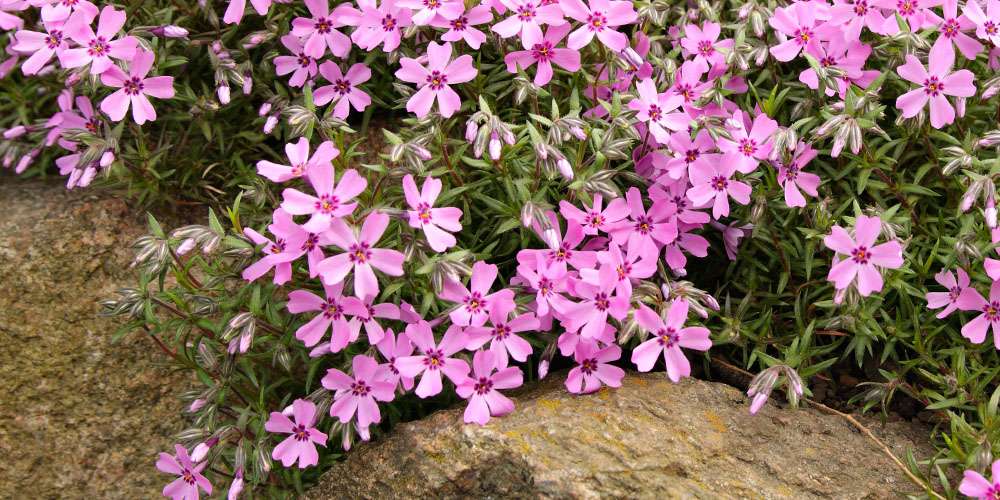
9. Periwinkle
Description
Periwinkle, scientifically known as Vinca minor, is a low-growing and trailing ground cover plant that features glossy, dark green leaves and delicate blue or purple flowers. It spreads quickly, forming a dense and vibrant carpet of foliage in your garden.
Benefits
Periwinkle offers several benefits for your garden. Firstly, its fast-growing and spreading nature makes it an excellent choice for filling in larger areas or as an underplanting for taller plants. Its dense carpet of foliage helps suppress weed growth, reducing the need for manual weeding or herbicides.
Moreover, Periwinkle’s vibrant and colorful flowers add a touch of beauty to your garden. The blue or purple flowers create a striking contrast against the glossy green leaves, enhancing the visual appeal of your outdoor space. Additionally, this ground cover plant is relatively low-maintenance and requires minimal care.
Maintenance
Maintaining Periwinkle is relatively straightforward. This plant prefers well-draining soil and thrives in a moderate amount of water. Regular watering is necessary, especially during dry spells, to ensure the health and vigor of the plant. However, be cautious not to overwater, as excessive moisture can lead to root rot.
To prevent overgrowth and maintain its shape, occasional trimming is recommended. Trimming will help control its spread and promote new growth. Additionally, removing any spent or faded flowers will encourage prolonged blooming and overall plant health.
Suitable Areas
Periwinkle is suitable for a variety of areas in your garden, such as slopes, banks, or as an underplanting for trees or shrubs. It thrives in partial shade to full shade and prefers well-draining soil. Periwinkle is hardy in USDA zones 4-9, making it a versatile choice for many climates.
10. Sweet Woodruff
Description
Sweet Woodruff, scientifically known as Galium odoratum, is a shade-loving and fragrant ground cover plant that features whorls of lance-shaped leaves and clusters of delicate white flowers. The leaves of Sweet Woodruff release a pleasant and sweet fragrance when crushed or bruised.
Benefits
Sweet Woodruff offers several benefits for your garden. Firstly, its shade-loving nature makes it an excellent choice for areas with limited sunlight, such as under trees or in woodland gardens. It adds a touch of vibrancy and fragrance to these shaded areas, enhancing the overall atmosphere.
Moreover, Sweet Woodruff’s aromatic leaves make it a popular choice for use in potpourri or herbal sachets. The leaves release a sweet scent when dried, providing a natural and pleasant fragrance in your home. Additionally, this ground cover plant attracts pollinators such as bees and butterflies, promoting biodiversity in your garden.
Maintenance
Maintaining Sweet Woodruff is relatively low maintenance. This plant prefers moist soil, so regular watering is necessary, especially during dry spells or in hot weather. However, be cautious not to overwater, as excessive moisture can lead to root rot. It is essential to provide adequate drainage to prevent waterlogged conditions.
To prevent overgrowth and maintain its shape, occasional trimming is recommended. Trimming will help control its spread and promote new growth. Additionally, removing any spent flowers or diseased foliage will contribute to the overall health and appearance of the plant.
Suitable Areas
Sweet Woodruff is suitable for various areas in your garden, such as woodland gardens, shaded borders, or as a ground cover under trees. It thrives in shaded or partially shaded areas and prefers well-draining soil. Sweet Woodruff is hardy in USDA zones 4-8, making it suitable for regions with cooler climates.
Ground cover plants are an excellent addition to any garden. They provide numerous benefits, from stabilizing soil and controlling erosion to suppressing weeds and attracting pollinators. Each variety discussed in this article offers unique characteristics and growth habits, making them suitable for different areas and conditions in your garden.
Whether you choose Creeping Thyme, Corsican Mint, Creeping Jenny, Dwarf Mondo Grass, Woolly Thyme, Mazus reptans, Blue Star Creeper, Irish Moss, Periwinkle, or Sweet Woodruff, you can enjoy the beauty and functionality that these ground cover plants bring. By selecting the right ground cover plants for your garden and providing proper maintenance, you can create a visually appealing and healthy outdoor space.
